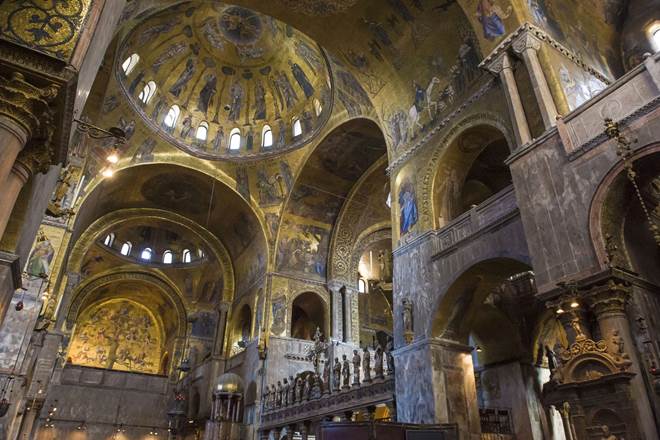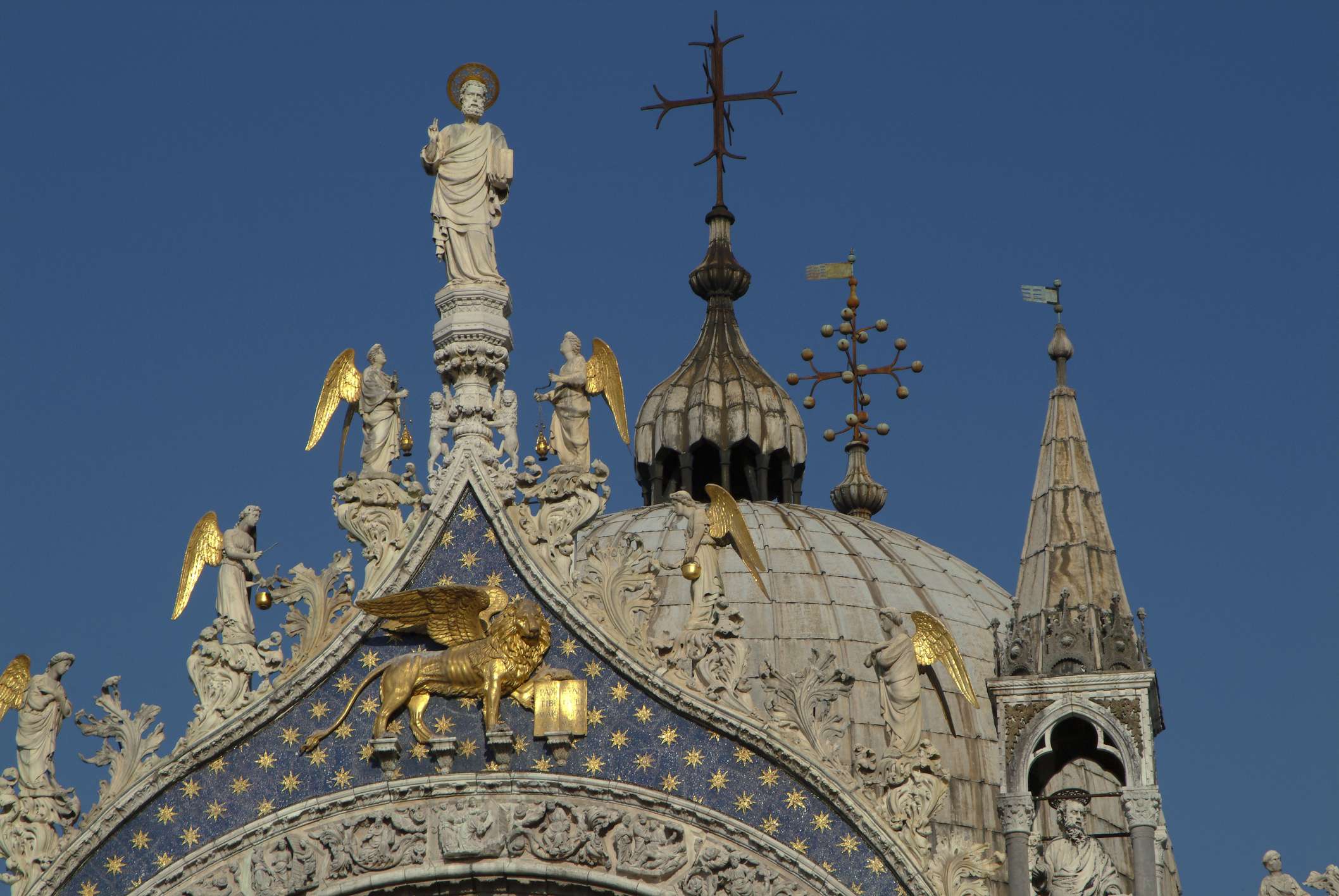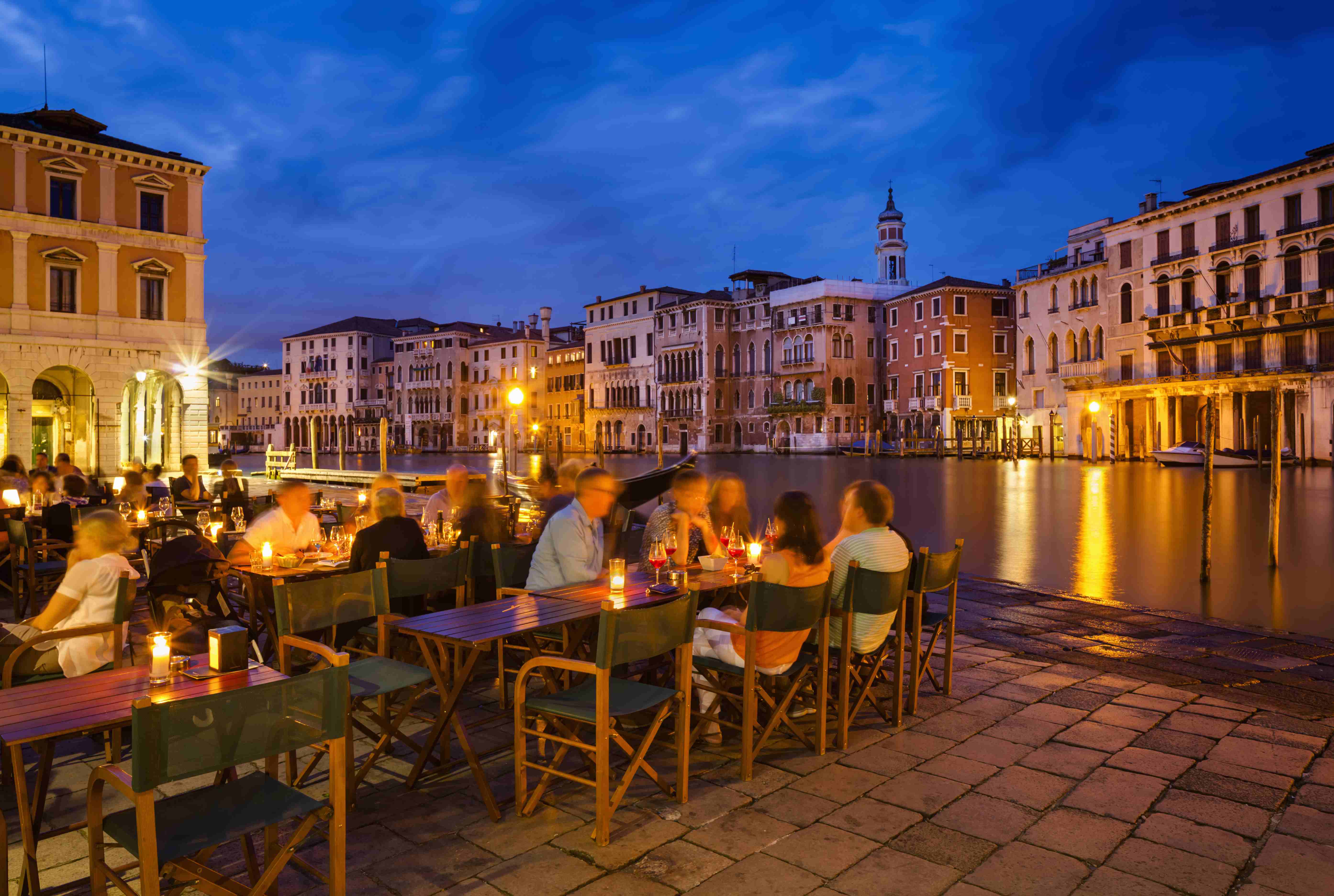Whether it’s your first or fiftieth time visiting Venice, you’ll surely want to go to Saint Mark’s Square. It’s the city’s former political and religious centre, home to its crowning jewel, Saint Mark’s Basilica.
The Patriarchal Cathedral Basilica of Saint Mark, or Saint Mark’s Basilica for short, combines Byzantine, Romanesque and Gothic styles – don’t forget your camera! This building is one of the most attractive in Venice.
What’s in this guide?
- Things to see at Saint Mark’s Basilica
- Saint Mark’s Basilica history and facts
- Bars, restaurants and shops nearby
- Opening times and ticket prices
How to get to Saint Mark’s Basilica
The best ways to get around Venice are by boat or on foot, depending on where you are, where you’re going and how much you’re willing to walk. To get to Saint Mark’s Basilica from Venezia Santa Lucia train station, you can take the water bus line 1, 2 or 51 to get directly to Saint Mark’s Square in 25 to 35 minutes.
Of course, once you’re in Venice, walking around is a great way to see the city up close. Take water buses to cover longer distances and – if you can – stroll between landmarks to soak up the sights.
What to see at Saint Mark’s Basilica
The church we know today is the third iteration of Saint Mark’s Basilica. Like its predecessors, the architecture was modelled on the Church of the Holy Apostles in Constantinople, with modifications to meet Venetian needs.
Look out for Byzantine, Romanesque, Gothic and Islamic influences in the Basilica’s design. Original brick façades have been decorated with colourful glass, precious stones and gold to display the Venetian Republic’s power. Inside, the church’s domes, vaults and walls are covered with more than 8,000 square metres of golden mosaics.
Façades
Saint Mark’s Basilica boasts three beautiful exposed façades, which have transformed throughout the centuries into the unique design we know today.
The Western Façade features five deep recesses. The sculptures on this side of the Basilica are decorative. The relief sculptures of Hercules with the Erymanthian boar and Saint Demetrius are ancient pieces taken from Constantinople during the Fourth Crusade. The other four sculptures of Hercules, Saint George, the Virgin and the Archangel Gabriel were carved in Venice to imitate Eastern works.
Lower down the Western Façade, sculptures are surrounded by intricately carved foliage. There’s also a mosaic here showing the removal of Saint Mark’s body from Egypt and its arrival in Venice; this is the only surviving mosaic from the 13th century.
The Horses of Saint Mark
The four gilded bronze horses were some of the first items brought to Venice during the Fourth Crusade. They’re the only equestrian sculptures to survive the period. They were added to the main façade of Saint Mark’s Basilica in the mid-13th century to symbolise Venice’s victory over Byzantium. In 1947, the original horses were moved inside and replaced with copies outside.
Mosaics
Many people picture dazzling mosaics when thinking of Saint Mark’s Basilica. Take one look inside, and it’s easy to understand why. The gold-ground patterns show saints, prophets and biblical scenes.
Retouches and repairs throughout the years mean the Saint Mark’s Basilica mosaics reflect centuries of artistic tastes. Some are traditional Byzantine and Medieval representations, while others are based on Renaissance paintings.
The narthex
A narthex is an architectural feature typical of Byzantine churches and basilicas. The striking mosaics in the Saint Mark’s Basilica narthex are sure to catch your eye; they represent the stories of Genesis and Exodus. The beautiful gold, green and blue tiles focus on Creation, the Tower of Babel and the lives of Noah, Abraham, Joseph and Moses.
The Bell Tower
The Campanile di San Marco, the Basilica’s iconic Bell Tower, is almost 100 metres high. It’s crowned by a gold-gilded sculpture of the Archangel Gabriel. Worried about climbing all those stairs? Good news! A lift inside can carry you to the top in just 30 seconds.
The Pala d’Oro
Saint Mark’s Basilica boasts a beautiful altar retable (Pala d’Oro), comprising around 250 ornamental parts set on sheet gold. There are enamel representations of prophets, apostles and angels, and panels representing the lives of Christ and Saint Mark.
The Pala d’Oro is considered the most precious example of Byzantine artistry and belief. The history of this beloved work dates to the early 12th century, with additions made and a frame added in the 13th and 14th centuries.
Saint Mark’s Basilica history and facts
Saint Mark’s Basilica was founded in 828AD when the relics of Saint Mark were brought (or stolen) to Venice from Egypt. At the time, the Basilica was a temporary building attached to the Doge’s Palace.
Throughout the centuries, the Basilica has undergone many transformations. It became a permanent church in 832 but burnt down in 967. A project in 1063 created the basis for the Saint Mark’s Basilica we know today.
The church was consecrated and dedicated to the Patron Saint in 1094. It became the Patriarch of Venice and the City Cathedral soon after.
Restaurants, bars and shops nearby
All that sightseeing is sure to work up an appetite. Perhaps you’re in the mood for a light bite and a glass of wine, or maybe you just want an aperitivo to cool off. Thanks to its central Venice location, Saint Mark’s Basilica is surrounded by many of the city’s best cafés, restaurants and bars.
Cafés and restaurants
- Ristorante La Piazza – serving Italian favourites like pizza, pasta and seafood with outdoor seating, perfect for people watching
- Trattoria Al Gazzettino – a rustic setting to enjoy classic meat and fish dishes
- Bistrot de Venise – for traditional Venetian dishes and an extensive wine list
- Le Maschere – a sophisticated Venetian spot with roof terrace seating
- Ostaria A La Campana – a casual favourite where it’s all about the food
- Trattoria Alla Scala – a cosy trattoria for excellent Italian food and atmosphere
Bars
- Bar Longhi – a classic hotel cocktail bar with a terrace overlooking the Grand Canal and Venetian landmarks
- Bar Dandolo – a sophisticated bar in luxury Hotel Danieli
- Ai Stagneri – a hidden café-bar, perfect for a quiet, casual drink
- Wine Bar 5000 – a welcoming wine bar with an extensive choice of bottles and glasses
- Canal Bar – an atmospheric bar away from the crowds
Shops
Want to pick up a souvenir to remember your time in Venice? Maybe you’re looking to make the most of the city’s many stylish clothes, jewellery and homeware shops. Saint Mark’s Basilica is close to many of the best shops around.
Read our guide to shopping in Venice for tips about where to go.
Opening times and ticket prices
Ready to visit Saint Mark’s Basilica? It’s open from 09:30 until 17:15 every Monday to Saturday. If you plan to go on a Sunday, you won’t be able to get inside until 14:00 due to the morning service. Entry costs just €3*, while children under six can go inside for free. A €5* supplement is required to see the Pala d’Oro.
However, you can still visit the Museum – Loggia dei Cavalli on Sunday mornings, when the rest of the Basilica is closed to tourists. The museum displays Flemish and Medicean tapestry, other furnishings and the original Four Horses of Saint Mark. Museum entry costs €7*, it’s free for children under six.
The Bell Tower is open every day from 09:30 to 17:15. Tickets cost €10*, entry is free for children under six.
*Prices correct as of March 2022
Travelling by train to Venice?
If you're planning to visit Venice, why not travel by train? Travelling to Venice by train is easy due to the high-speed rail connections operated by Trenitalia and Italo. You can travel to Venice from some of the most popular locations in Italy, including Peschiera del Garda to Venice (1h 16m), Verona Porta Nuova to Venice (1h) and Trieste Centrale to Venice (1h 37m).
Need more information about travelling to Venice by train? Check out our dedicated page to trains to Venice.


